Page 49 of 93
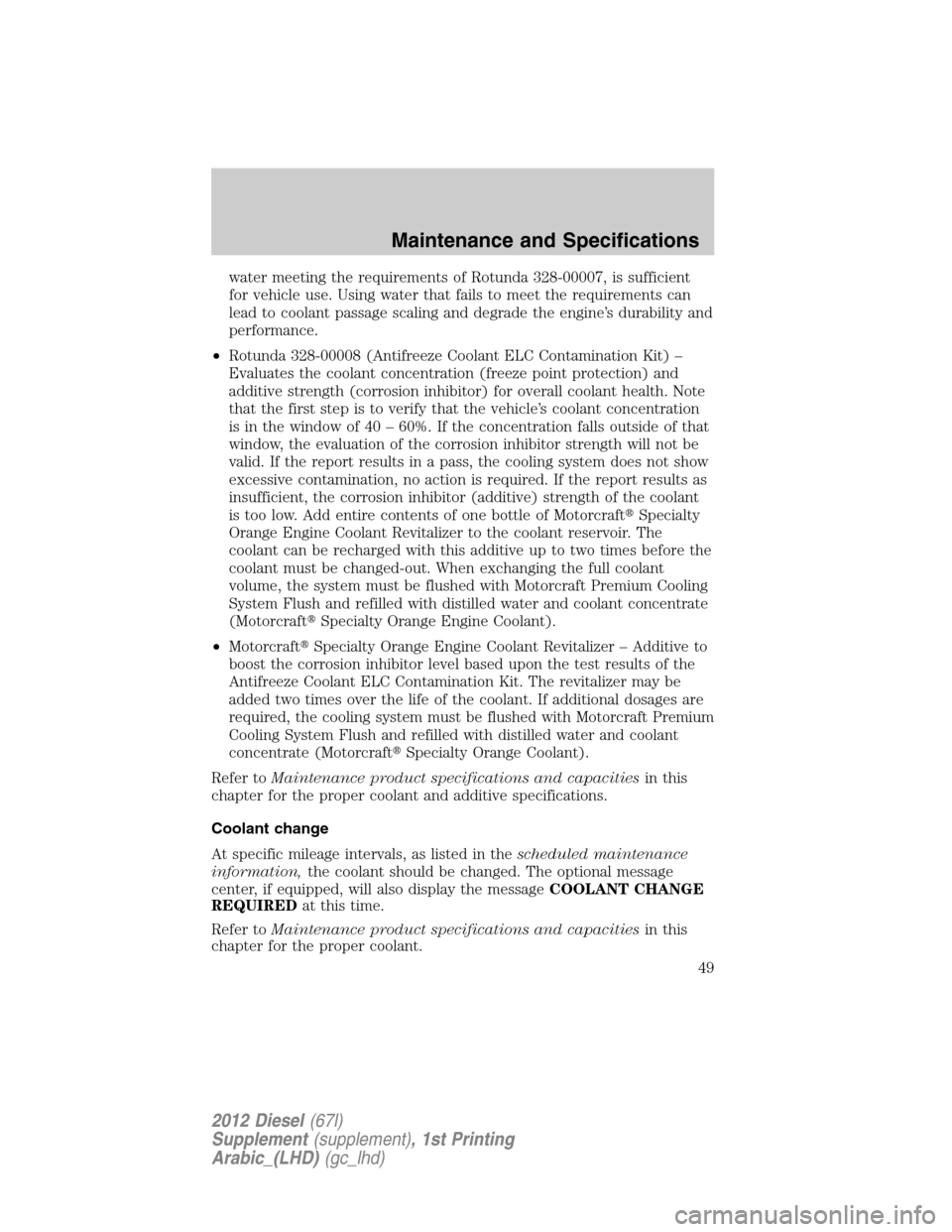
water meeting the requirements of Rotunda 328-00007, is sufficient
for vehicle use. Using water that fails to meet the requirements can
lead to coolant passage scaling and degrade the engine’s durability and
performance.
•Rotunda 328-00008 (Antifreeze Coolant ELC Contamination Kit) –
Evaluates the coolant concentration (freeze point protection) and
additive strength (corrosion inhibitor) for overall coolant health. Note
that the first step is to verify that the vehicle’s coolant concentration
is in the window of 40 – 60%. If the concentration falls outside of that
window, the evaluation of the corrosion inhibitor strength will not be
valid. If the report results in a pass, the cooling system does not show
excessive contamination, no action is required. If the report results as
insufficient, the corrosion inhibitor (additive) strength of the coolant
is too low. Add entire contents of one bottle of Motorcraft�Specialty
Orange Engine Coolant Revitalizer to the coolant reservoir. The
coolant can be recharged with this additive up to two times before the
coolant must be changed-out. When exchanging the full coolant
volume, the system must be flushed with Motorcraft Premium Cooling
System Flush and refilled with distilled water and coolant concentrate
(Motorcraft�Specialty Orange Engine Coolant).
•Motorcraft�Specialty Orange Engine Coolant Revitalizer – Additive to
boost the corrosion inhibitor level based upon the test results of the
Antifreeze Coolant ELC Contamination Kit. The revitalizer may be
added two times over the life of the coolant. If additional dosages are
required, the cooling system must be flushed with Motorcraft Premium
Cooling System Flush and refilled with distilled water and coolant
concentrate (Motorcraft�Specialty Orange Coolant).
Refer toMaintenance product specifications and capacitiesin this
chapter for the proper coolant and additive specifications.
Coolant change
At specific mileage intervals, as listed in thescheduled maintenance
information,the coolant should be changed. The optional message
center, if equipped, will also display the messageCOOLANT CHANGE
REQUIREDat this time.
Refer toMaintenance product specifications and capacitiesin this
chapter for the proper coolant.
Maintenance and Specifications
49
2012 Diesel(67l)
Supplement(supplement), 1st Printing
Arabic_(LHD)(gc_lhd)
Page 50 of 93
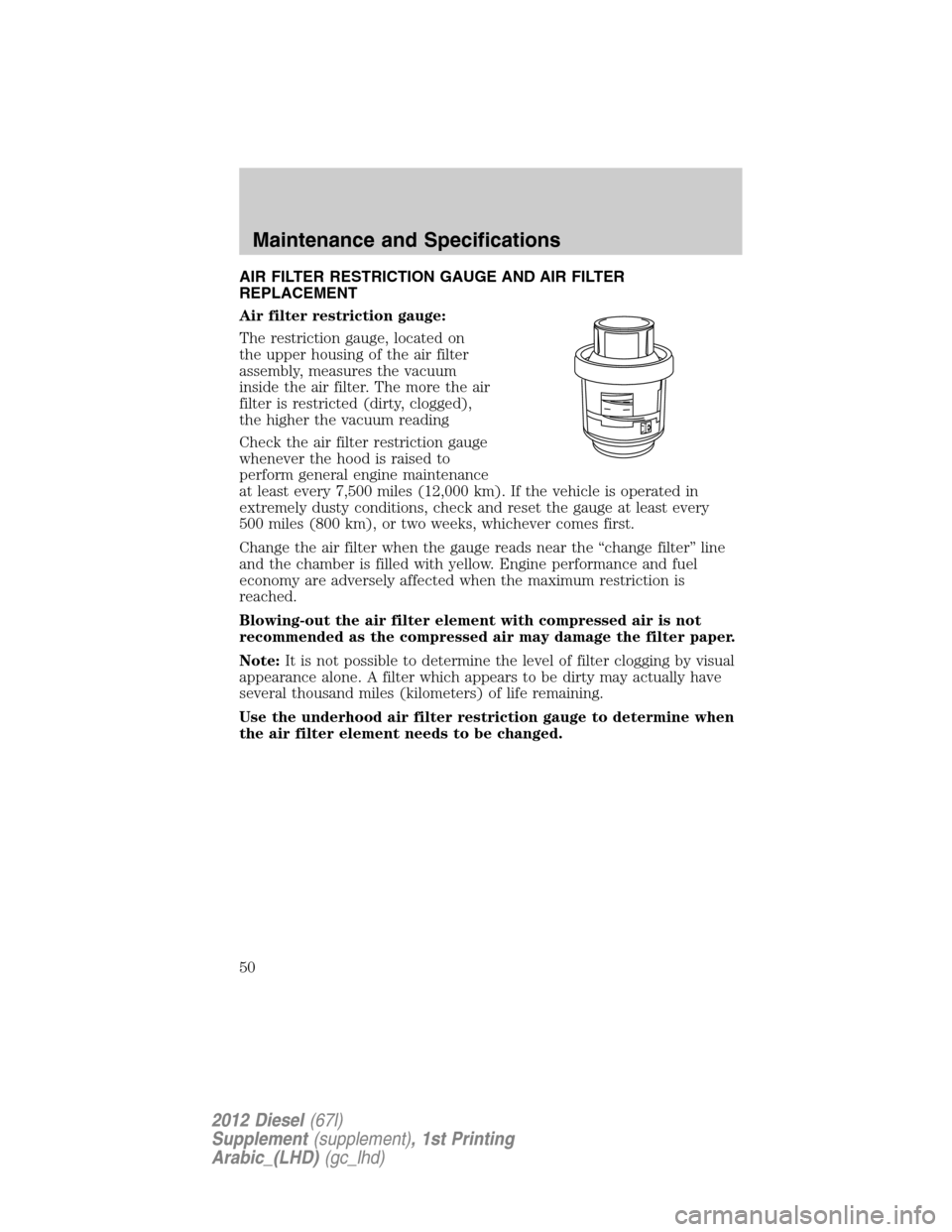
AIR FILTER RESTRICTION GAUGE AND AIR FILTER
REPLACEMENT
Air filter restriction gauge:
The restriction gauge, located on
the upper housing of the air filter
assembly, measures the vacuum
inside the air filter. The more the air
filter is restricted (dirty, clogged),
the higher the vacuum reading
Check the air filter restriction gauge
whenever the hood is raised to
perform general engine maintenance
at least every 7,500 miles (12,000 km). If the vehicle is operated in
extremely dusty conditions, check and reset the gauge at least every
500 miles (800 km), or two weeks, whichever comes first.
Change the air filter when the gauge reads near the “change filter” line
and the chamber is filled with yellow. Engine performance and fuel
economy are adversely affected when the maximum restriction is
reached.
Blowing-out the air filter element with compressed air is not
recommended as the compressed air may damage the filter paper.
Note:It is not possible to determine the level of filter clogging by visual
appearance alone. A filter which appears to be dirty may actually have
several thousand miles (kilometers) of life remaining.
Use the underhood air filter restriction gauge to determine when
the air filter element needs to be changed.
Maintenance and Specifications
50
2012 Diesel(67l)
Supplement(supplement), 1st Printing
Arabic_(LHD)(gc_lhd)
Page 51 of 93
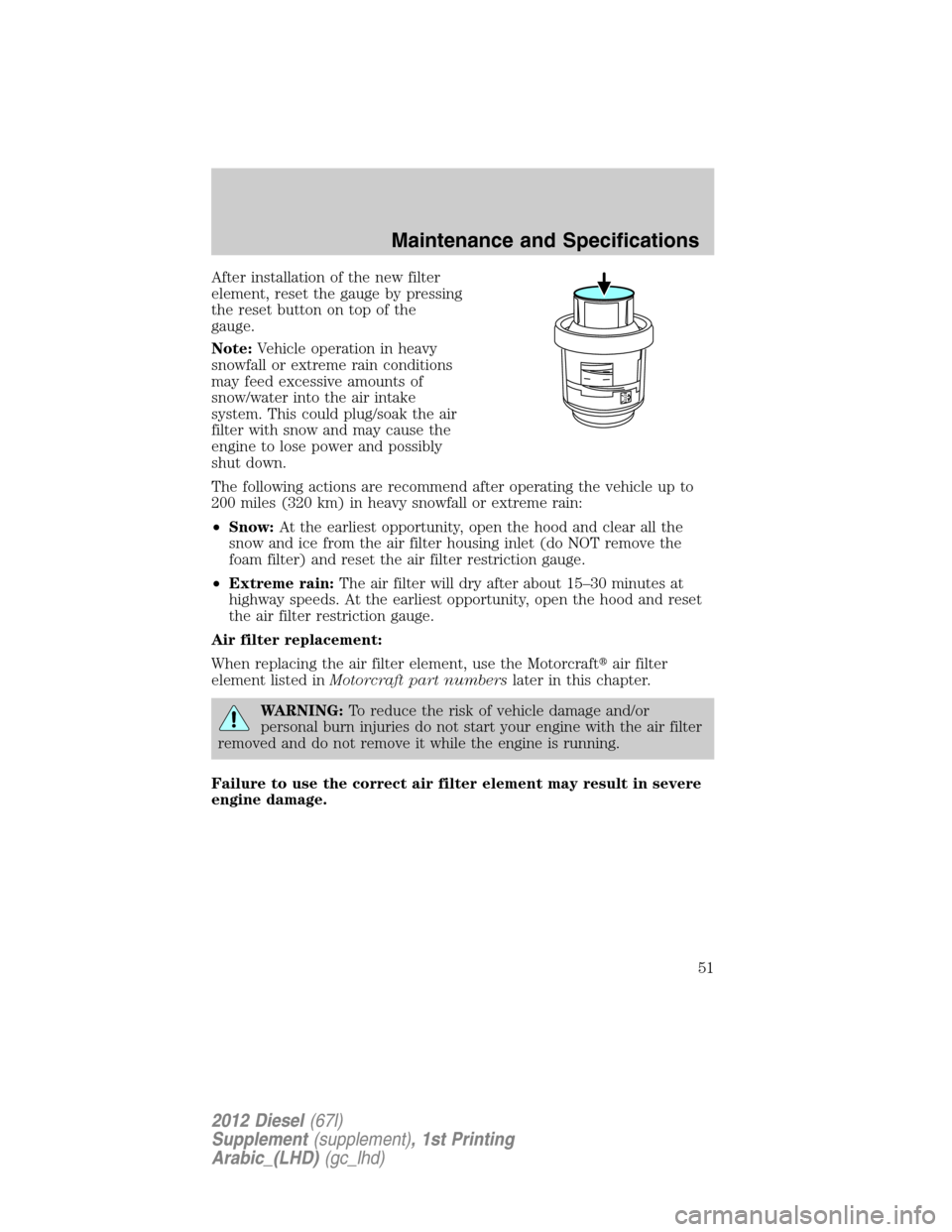
After installation of the new filter
element, reset the gauge by pressing
the reset button on top of the
gauge.
Note:Vehicle operation in heavy
snowfall or extreme rain conditions
may feed excessive amounts of
snow/water into the air intake
system. This could plug/soak the air
filter with snow and may cause the
engine to lose power and possibly
shut down.
The following actions are recommend after operating the vehicle up to
200 miles (320 km) in heavy snowfall or extreme rain:
•Snow:At the earliest opportunity, open the hood and clear all the
snow and ice from the air filter housing inlet (do NOT remove the
foam filter) and reset the air filter restriction gauge.
•Extreme rain:The air filter will dry after about 15–30 minutes at
highway speeds. At the earliest opportunity, open the hood and reset
the air filter restriction gauge.
Air filter replacement:
When replacing the air filter element, use the Motorcraft�air filter
element listed inMotorcraft part numberslater in this chapter.
WARNING:To reduce the risk of vehicle damage and/or
personal burn injuries do not start your engine with the air filter
removed and do not remove it while the engine is running.
Failure to use the correct air filter element may result in severe
engine damage.
Maintenance and Specifications
51
2012 Diesel(67l)
Supplement(supplement), 1st Printing
Arabic_(LHD)(gc_lhd)
Page 52 of 93
1. Locate the mass air flow sensor
electrical connector on the air inlet
tube. This connector will need to be
unplugged.
Unlock the locking clip on the
connector, then squeeze and pull
the connector off of the air inlet
tube.
2. Release the four clamps that
secure the cover to the air filter
housing. Push the air filter cover
forward (away from you) and up
slightly to release it.
3. Remove the air filter element from the air filter housing.
Maintenance and Specifications
52
2012 Diesel(67l)
Supplement(supplement), 1st Printing
Arabic_(LHD)(gc_lhd)
Page 53 of 93
4. Remove and install a new foam
filter if needed according to the
service interval indicated in the
scheduled maintenance
informationin this guide. If the
foam filter is not being replaced, be
sure the existing foam filter is in
place.
5. Install a new air filter element. be
sure that the groove seal on the
pleated paper filter traps both sides
of the vertical partition of the air
box.
6. Replace the air filter housing
cover and secure the clamps. Be
careful not to crimp the filter
element edges between the air filter
housing and cover and ensure that
the tabs on the edge are properly
aligned into the slots.
7. Reconnect the mass air flow sensor electrical connector to the inlet
tube. Make sure the locking tab on the connector is in the “locked”
position.
Maintenance and Specifications
53
2012 Diesel(67l)
Supplement(supplement), 1st Printing
Arabic_(LHD)(gc_lhd)
Page 54 of 93
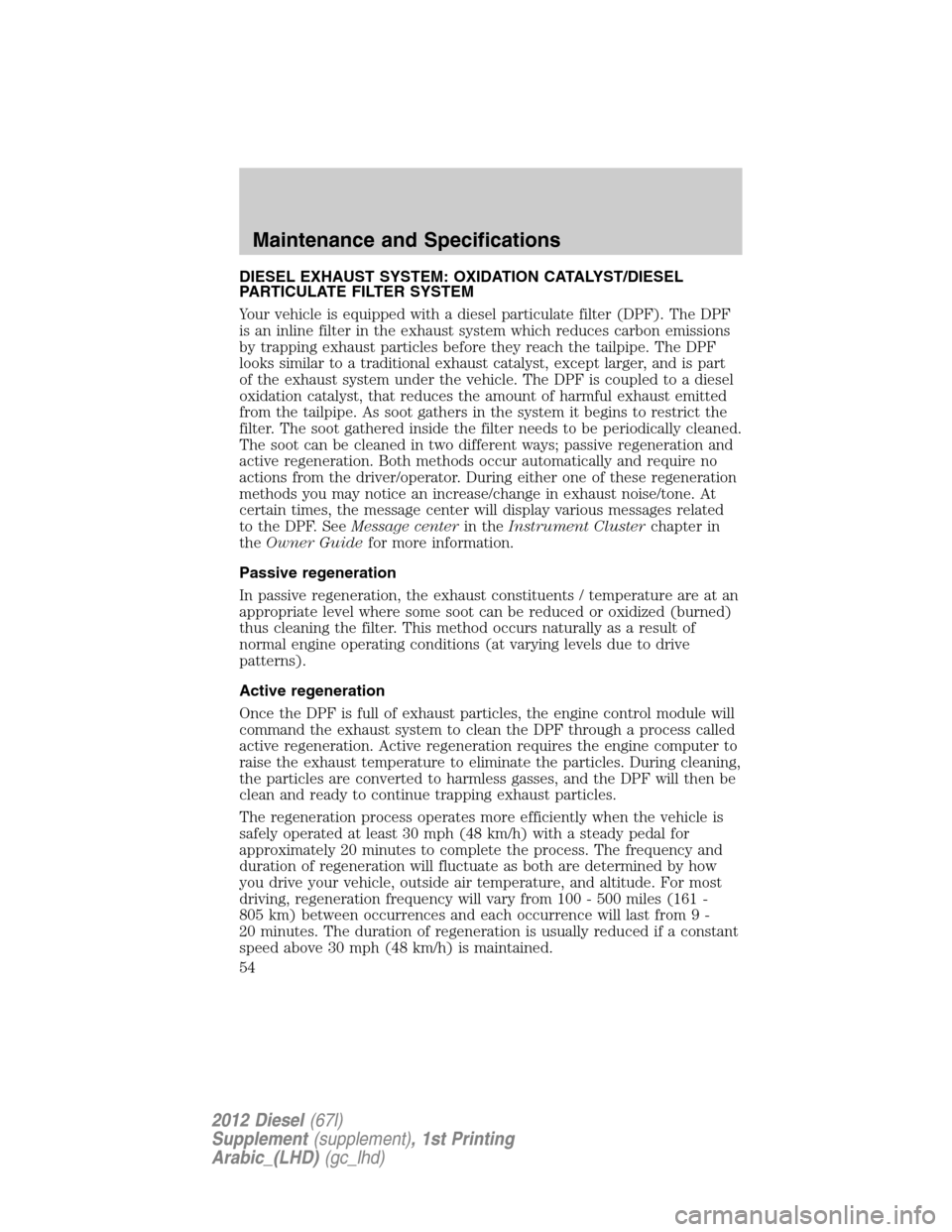
DIESEL EXHAUST SYSTEM: OXIDATION CATALYST/DIESEL
PARTICULATE FILTER SYSTEM
Your vehicle is equipped with a diesel particulate filter (DPF). The DPF
is an inline filter in the exhaust system which reduces carbon emissions
by trapping exhaust particles before they reach the tailpipe. The DPF
looks similar to a traditional exhaust catalyst, except larger, and is part
of the exhaust system under the vehicle. The DPF is coupled to a diesel
oxidation catalyst, that reduces the amount of harmful exhaust emitted
from the tailpipe. As soot gathers in the system it begins to restrict the
filter. The soot gathered inside the filter needs to be periodically cleaned.
The soot can be cleaned in two different ways; passive regeneration and
active regeneration. Both methods occur automatically and require no
actions from the driver/operator. During either one of these regeneration
methods you may notice an increase/change in exhaust noise/tone. At
certain times, the message center will display various messages related
to the DPF. SeeMessage centerin theInstrument Clusterchapter in
theOwner Guidefor more information.
Passive regeneration
In passive regeneration, the exhaust constituents / temperature are at an
appropriate level where some soot can be reduced or oxidized (burned)
thus cleaning the filter. This method occurs naturally as a result of
normal engine operating conditions (at varying levels due to drive
patterns).
Active regeneration
Once the DPF is full of exhaust particles, the engine control module will
command the exhaust system to clean the DPF through a process called
active regeneration. Active regeneration requires the engine computer to
raise the exhaust temperature to eliminate the particles. During cleaning,
the particles are converted to harmless gasses, and the DPF will then be
clean and ready to continue trapping exhaust particles.
The regeneration process operates more efficiently when the vehicle is
safely operated at least 30 mph (48 km/h) with a steady pedal for
approximately 20 minutes to complete the process. The frequency and
duration of regeneration will fluctuate as both are determined by how
you drive your vehicle, outside air temperature, and altitude. For most
driving, regeneration frequency will vary from 100 - 500 miles (161 -
805 km) between occurrences and each occurrence will last from 9 -
20 minutes. The duration of regeneration is usually reduced if a constant
speed above 30 mph (48 km/h) is maintained.
Maintenance and Specifications
54
2012 Diesel(67l)
Supplement(supplement), 1st Printing
Arabic_(LHD)(gc_lhd)
Page 55 of 93
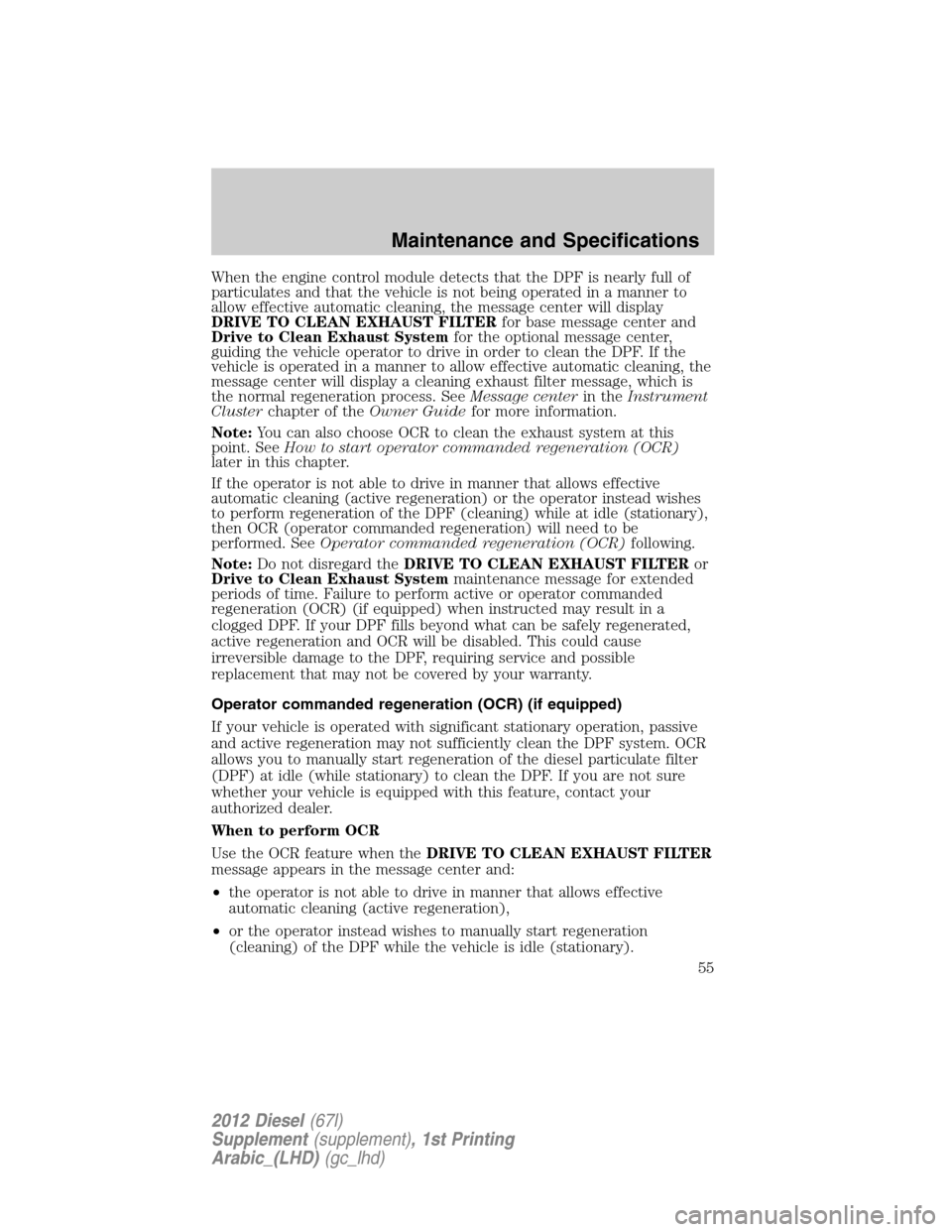
When the engine control module detects that the DPF is nearly full of
particulates and that the vehicle is not being operated in a manner to
allow effective automatic cleaning, the message center will display
DRIVE TO CLEAN EXHAUST FILTERfor base message center and
Drive to Clean Exhaust Systemfor the optional message center,
guiding the vehicle operator to drive in order to clean the DPF. If the
vehicle is operated in a manner to allow effective automatic cleaning, the
message center will display a cleaning exhaust filter message, which is
the normal regeneration process. SeeMessage centerin theInstrument
Clusterchapter of theOwner Guidefor more information.
Note:You can also choose OCR to clean the exhaust system at this
point. SeeHow to start operator commanded regeneration (OCR)
later in this chapter.
If the operator is not able to drive in manner that allows effective
automatic cleaning (active regeneration) or the operator instead wishes
to perform regeneration of the DPF (cleaning) while at idle (stationary),
then OCR (operator commanded regeneration) will need to be
performed. SeeOperator commanded regeneration (OCR)following.
Note:Do not disregard theDRIVE TO CLEAN EXHAUST FILTERor
Drive to Clean Exhaust Systemmaintenance message for extended
periods of time. Failure to perform active or operator commanded
regeneration (OCR) (if equipped) when instructed may result in a
clogged DPF. If your DPF fills beyond what can be safely regenerated,
active regeneration and OCR will be disabled. This could cause
irreversible damage to the DPF, requiring service and possible
replacement that may not be covered by your warranty.
Operator commanded regeneration (OCR) (if equipped)
If your vehicle is operated with significant stationary operation, passive
and active regeneration may not sufficiently clean the DPF system. OCR
allows you to manually start regeneration of the diesel particulate filter
(DPF) at idle (while stationary) to clean the DPF. If you are not sure
whether your vehicle is equipped with this feature, contact your
authorized dealer.
When to perform OCR
Use the OCR feature when theDRIVE TO CLEAN EXHAUST FILTER
message appears in the message center and:
•the operator is not able to drive in manner that allows effective
automatic cleaning (active regeneration),
•or the operator instead wishes to manually start regeneration
(cleaning) of the DPF while the vehicle is idle (stationary).
Maintenance and Specifications
55
2012 Diesel(67l)
Supplement(supplement), 1st Printing
Arabic_(LHD)(gc_lhd)
Page 56 of 93
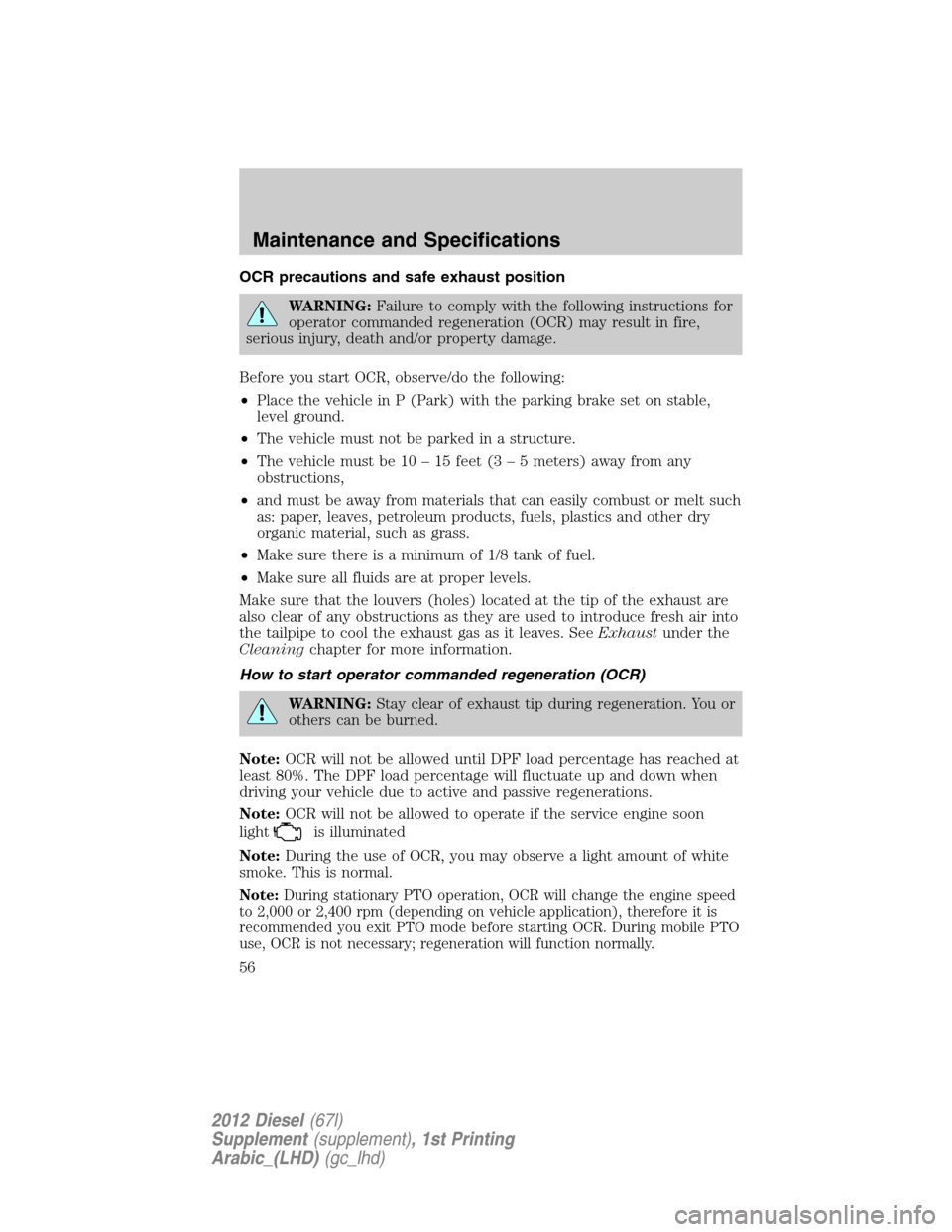
OCR precautions and safe exhaust position
WARNING:Failure to comply with the following instructions for
operator commanded regeneration (OCR) may result in fire,
serious injury, death and/or property damage.
Before you start OCR, observe/do the following:
•Place the vehicle in P (Park) with the parking brake set on stable,
level ground.
•The vehicle must not be parked in a structure.
•The vehicle must be 10 – 15 feet (3 – 5 meters) away from any
obstructions,
•and must be away from materials that can easily combust or melt such
as: paper, leaves, petroleum products, fuels, plastics and other dry
organic material, such as grass.
•Make sure there is a minimum of 1/8 tank of fuel.
•Make sure all fluids are at proper levels.
Make sure that the louvers (holes) located at the tip of the exhaust are
also clear of any obstructions as they are used to introduce fresh air into
the tailpipe to cool the exhaust gas as it leaves. SeeExhaustunder the
Cleaningchapter for more information.
How to start operator commanded regeneration (OCR)
WARNING:Stay clear of exhaust tip during regeneration. You or
others can be burned.
Note:OCR will not be allowed until DPF load percentage has reached at
least 80%. The DPF load percentage will fluctuate up and down when
driving your vehicle due to active and passive regenerations.
Note:OCR will not be allowed to operate if the service engine soon
light
is illuminated
Note:During the use of OCR, you may observe a light amount of white
smoke. This is normal.
Note:During stationary PTO operation, OCR will change the engine speed
to 2,000 or 2,400 rpm (depending on vehicle application), therefore it is
recommended you exit PTO mode before starting OCR. During mobile PTO
use, OCR is not necessary; regeneration will function normally.
Maintenance and Specifications
56
2012 Diesel(67l)
Supplement(supplement), 1st Printing
Arabic_(LHD)(gc_lhd)